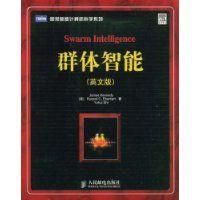群體智慧型(Swarm intelligence):
群體智慧型應該遵循五條基本原則:(1)鄰近原則(ProximityPrinciple),群體能夠進行簡單的空間和時間計算;
(2)品質原則(QualityPrinciple),群體能夠回響環境中的品質因子;
(3)多樣性反應原則(PrincipleofDiverseRe2sponse),群體的行動範圍不應該太窄;
(4)穩定性原則(StabilityPrinciple),群體不應在每次環境變化時都改變自身的行為;
(5)適應性原則(AdaptabilityPrinciple),在所需代價不太高的情況下,群體能夠在適當的時候改變自身的行為。
群體智慧型具有如下特點:
(1)控制是分散式的,不存在中心控制。因而它更能夠適應當前網路環境下的工作狀態,並且具有較強的魯棒性,即不會由於某一個或幾個個體出現故障而影響群體對整個問題的求解。
(2)群體中的每個個體都能夠改變環境,這是個體之間間接通信的一種方式,這種方式被稱為“激發工作”(Stigmergy)。由於群體智慧型可以通過非直接通信的方式進行信息的傳輸與合作,因而隨著個體數目的增加,通信開銷的增幅較小,因此,它具有較好的可擴充性。
(3)群體中每個個體的能力或遵循的行為規則非常簡單,因而群體智慧型的實現比較方便,具有簡單性的特點。
(4)群體表現出來的複雜行為是通過簡單個體的互動過程突現出來的智慧型(EmergentIntelli2gence),因此,群體具有自組織性。
英文版.群體智慧型
作者:(美國)JamesKennedy(美國)RussellCEberhart,YuhuiShi(史玉回)市場價:¥75.00
出版社:人民郵電出版社
頁碼:512頁
 群體智慧型
群體智慧型出版日期:2009年
ISBN:9787115195500
版本:1版
裝幀:平裝
開本:16
英語:英語
叢書名:圖靈原版計算機科學系列
內容簡介
群體智慧型是通過模擬自然界生物群體行為來實現人工智慧型的一種方法。《群體智慧型》綜合運用認知科學、社會心理學、人工智慧和演化計算等學科知識,提供了一些非常有價值的新見解,並將這些見解加以套用,以解決困難的工程問題。書中首先探討了基礎理論,然後詳盡展示如何將這些理論和模型套用於新的計算智慧型方法(粒子群)中,以適應智慧型系統的行為,最後描述了套用粒子群最佳化算法的好處,提供了強有力的最佳化、學習和問題解決的方法。《群體智慧型》主要面向計算機相關學科的高年級本科生或研究生以及相關領域的研究與開發技術人員。
作者簡介
JamesKennedy社會心理學家。自1994年起,他一直致力於粒子群算法的研究工作,並與RussellC.Eberhart共同開發了粒子群最佳化算法。目前在美國勞工部從事調查方法的研究工作。他在計算機科學和社會科學雜誌和學報上發表過許多關於粒子群的論文。RusselIC.Eberhart 普度大學電子與計算機工程系主任。IEEE會士。與JamesKennedy共同提出了粒子群最佳化算法。曾任IEEE神經網路委員會的主席。除了本書之外,他還著有《計算智慧型:從概念到實現》(影印版由人民郵電出版社出版)等。
 圖書室
圖書室YuhuiShi(史玉回)國際計算智慧型領域專家,現任JoumalofSwarmIntellgence編委,IEEECIS群體智慧型任務組主席,西交利物浦大學電子與電氣工程系教授。1992年獲東南大學博士學位,先後在美國、韓國、澳大利亞等地從事研究工作,曾任美國電子資訊系統公司專家長達9年。他還是《計算智慧型:從概念到實現》一書的作者之一。
媒體推薦
“本書內容豐富,富於啟發性和思想性,強烈推薦給所有的演進計算研究人員。”——GeneticProgrammingandEvolvable'Machines
“這本書極為出色,不愧為PSO和群體智慧型的最佳參考書:”
——KonstantionsE.Parsopoulos希臘Palras大學
編輯推薦
群體智慧型是近年來發展迅速的人工智慧學科領域。通過研究分散、自組織的動物群體和人類社會的智慧型行為,學者們提出了許多迥異於傳統思路的智慧型算法,很好地解決了不少原來非常棘手的複雜工程問題。與蟻群算法齊名的粒子群最佳化(particleswarmoptimizatiotl,簡稱PSO)算法就是其中最受矚目、套用最為廣泛的成果之一。《群體智慧型》由粒子群最佳化算法之父撰寫,是該領域毋庸置疑的經典著作。作者提出,人類智慧型來源於社會環境中個體之間的互動,這種智慧型模型可以有效地套用到人工智慧系統中去。書中首先從社會心理學、認知科學和演化計算等多個角度闡述了這種新方法的基礎,然後詳細說明了套用這些理論和模型所得出的新的計算智慧型方法——粒子群最佳化,進而深入地探討了如何將粒子群最佳化套用於廣泛的工程問題。
《群體智慧型》的C及ViSLlaIBasic原始碼可以在圖靈網站《群體智慧型》網頁免費註冊下載。
目錄
partoneFoundationschapterone ModelsandConceptsofLifeandIntelligence 3
TheMechanicsofLifeandThought 4
StochasticAdaptation:IsAnythingEverReallyRandom? 9
The“TwoGreatStochasticSystems” 12
TheGameofLife:EmergenceinComplexSystems 16
TheGameofLife 17
Emergence 18
CellularAutomataandtheEdgeofChaos 20
ArtificialLifeinComputerPrograms 26
Intelligence:GoodMindsinPeopleandMachines 30
IntelligenceinPeople:TheBoringCriterion 30
IntelligenceinMachines:TheTuringCriterion 32
chaptertwo Symbols,Connections,andOptimizationbyTrialandError 35
SymbolsinTreesandNetworks 36
ProblemSolvingandOptimization 48
ASuper-SimpleOptimizationProblem 49
ThreeSpacesofOptimization 51
FitnessLandscapes 52
High-DimensionalCognitiveSpaceandWordMeanings 55
TwoFactorsofComplexity:NKLandscapes 60
CombinatorialOptimization 64
BinaryOptimization 67
RandomandGreedySearches 71
HillClimbing 72
SimulatedAnnealing 73
BinaryandGrayCoding 74
StepSizesandGranularity 75
OptimizingwithRealNumbers 77
Summary 78
chapterthree OnOurNonexistenceasEntities:TheSocialOrganism 81
ViewsofEvolution 82
Gaia:TheLivingEarth 83
DifferentialSelection 86
OurMicroscopicMasters? 91
LookingfortheRightZoomAngle 92
Flocks,Herds,Schools,andSwarms:SocialBehaviorasOptimization 94
AccomplishmentsoftheSocialInsects 98
OptimizingwithSimulatedAnts:ComputationalSwarmIntelligence 105
StayingTogetherbutNotColliding:Flocks,Herds,andSchools 109
RobotSocieties 115
ShallowUnderstanding 125
Agency 129
Summary 131
chapterfour EvolutionaryComputationTheoryandParadigms 133
Introduction 134
EvolutionaryComputationHistory 134
TheFourAreasofEvolutionaryComputation 135
GeneticAlgorithms 135
EvolutionaryProgramming 139
EvolutionStrategies 140
GeneticProgramming 141
Towardunification 141
EvolutionaryComputationOverview 142
ECParadigmAttributes 142
Implementation 143
GeneticAlgorithms 146
AnOverview 146
ASimpleGAExampleProblem 147
AReviewofGAOperations 152
SchemataandtheSchemaTheorem 159
FinalCommentsonGeneticAlgorithms 163
EvolutionaryProgramming 164
TheEvolutionaryProgrammingProcedure 165
FiniteStateMachineEvolution 166
FunctionOptimization 169
FinalComments 171
EvolutionStrategies 172
Mutation 172
Recombination 174
Selection 175
GeneticProgramming 179
Summary 185
chapterfive Humans—Actual,Imagined,andImplied 187
StudyingMinds 188
TheFalloftheBehavioristEmpire 193
TheCognitiveRevolution 195
Bandura’sSocialLearningParadigm 197
SocialPsychology 199
Lewin’sFieldTheory 200
Norms,Conformity,andSocialInfluence 202
Sociocognition 205
SimulatingSocialInfluence 206
ParadigmShiftsinCognitiveScience 210
TheEvolutionofCooperation 214
ExplanatoryCoherence 216
NetworksinGroups 218
CultureinTheoryandPractice 220
CoordinationGames 223
TheElFarolProblem 226
Sugarscape 229
Tesfatsion’sACE 232
Picker’sCompeting-NormsModel 233
Latané’sDynamicSocialImpactTheory 235
BoydandRicherson’sEvolutionaryCultureModel 240
Memetics 245
MemeticAlgorithms 248
CulturalAlgorithms 253
ConvergenceofBasicandAppliedResearch 254
Culture—andLifewithoutIt 255
Summary 258
chaptersix ThinkingIsSocial 261
Introduction 262
AdaptationonThreeLevels 263
TheAdaptiveCultureModel 263
Axelrod’sCultureModel 265
ExperimentOne:SimilarityinAxelrod’sModel 267
ExperimentTwo:OptimizationofanArbitraryFunction 268
ExperimentThree:ASlightlyHarderandMoreInterestingFunction 269
ExperimentFour:AHardFunction 271
ExperimentFive:ParallelConstraintSatisfaction 273
ExperimentSix:SymbolProcessing 279
Discussion 282
Summary 284
parttwo TheParticleSwarmandCollectiveIntelligence
chapterseven TheParticleSwarm 287
SociocognitiveUnderpinnings:Evaluate,Compare,andImitate 288
Evaluate 288
Compare 288
Imitate 289
AModelofBinaryDecision 289
TestingtheBinaryAlgorithmwiththeDeJongTestSuite 297
NoFreeLunch 299
Multimodality 302
MindsasParallelConstraintSatisfactionNetworksinCultures 307
TheParticleSwarminContinuousNumbers 309
TheParticleSwarminReal-NumberSpace 309
PseudocodeforParticleSwarmOptimizationinContinuousNumbers 313
ImplementationIssues 314
AnExample:ParticleSwarmOptimizationofNeuralNetWeights 314
AReal-WorldApplication 318
TheHybridParticleSwarm 319
ScienceasCollaborativeSearch 320
EmergentCulture,ImmergentIntelligence 323
Summary 324
chaptereight VariationsandComparisons 327
VariationsoftheParticleSwarmParadigm 328
ParameterSelection 328
ControllingtheExplosion 337
ParticleInteractions 342
NeighborhoodTopology 343
SubstitutingClusterCentersforPreviousBests 347
AddingSelectiontoParticleSwarms 353
ComparingInertiaWeightsandConstrictionFactors 354
AsymmetricInitialization 357
SomeThoughtsonVariations 359
AreParticleSwarmsReallyaKindofEvolutionaryAlgorithm? 361
EvolutionbeyondDarwin 362
SelectionandSelf-Organization 363
Ergodicity:WhereCanItGetfromHere? 366
ConvergenceofEvolutionaryComputationandParticleSwarms 367
Summary 368
chapternine Applications 369
EvolvingNeuralNetworkswithParticleSwarms 370
ReviewofPreviousWork 370
AdvantagesandDisadvantagesofPreviousApproaches 374
TheParticleSwarmOptimizationImplementationUsedHere 376
ImplementingNeuralNetworkEvolution 377
AnExampleApplication 379
Conclusions 381
HumanTremorAnalysis 382
DataAcquisitionUsingActigraphy 383
DataPreprocessing 385
AnalysiswithParticleSwarmOptimization 386
Summary 389
OtherApplications 389
ComputerNumericallyControlledMillingOptimization 389
IngredientMixOptimization 391
ReactivePowerandVoltageControl 391
BatteryPackState-of-ChargeEstimation 391
Summary 392
chapterten ImplicationsandSpeculations 393
Introduction 394
Assertions 395
UpfromSocialLearning:Bandura 398
InformationandMotivation 399
vicariousversusDirectExperience 399
TheSpreadofInfluence 400
MachineAdaptation 401
LearningorAdaptation? 402
CellularAutomata 403
DownfromCulture 405
SoftComputing 408
InteractionwithinSmallGroups:GroupPolarization 409
InformationalandnormativeSocialInfluence 411
Self-Esteem 412
Self-AttributionandSocialIllusion 414
Summary 419
chaptereleven AndinConclusion... 421
AppendixAStatisticsforSwarmers 429
AppendixBGeneticAlgorithmImplementation 451
Glossary 457
References 475
Index 497
……
